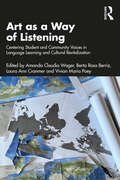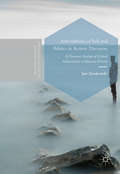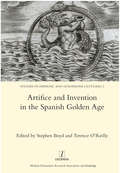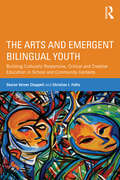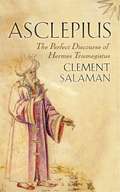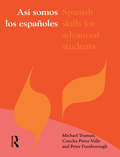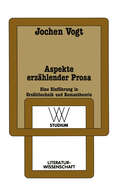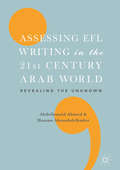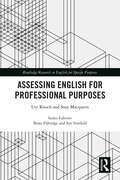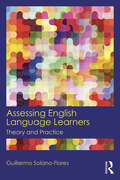- Table View
- List View
Art as a Way of Listening: Centering Student and Community Voices in Language Learning and Cultural Revitalization
by Amanda Claudia Wager Berta Rosa Berriz Laura Ann Cranmer Vivian Maria PoeyOffering a wealth of art-based practices, this volume invites readers to reimagine the joyful possibility and power of language and culture in language and literacy learning. Understanding art as a tool that can be used for decolonizing minds, the contributors explore new methods and strategies for supporting the language and literacy learning skills of multilingual students. Contributors are artists, educators, and researchers who bring together cutting-edge theory and practice to present a broad range of traditional and innovative art forms and media that spotlight the roles of artful resistance and multilingual activism. Featuring questions for reflection and curricular applications, chapters address theoretical issues and pedagogical strategies related to arts and language learning, including narrative inquiry, journaling, social media, oral storytelling, and advocacy projects. The innovative methods and strategies in this book demonstrate how arts-based, decolonizing practices are essential in fostering inclusive educational environments and supporting multilingual students’ cultural and linguistic repertoires. Transformative and engaging, this text is a key resource for educators, scholars, and researchers in literacy and language education.
Art as a Way of Listening: Centering Student and Community Voices in Language Learning and Cultural Revitalization
by Amanda Claudia Wager Berta Rosa Berriz Laura Ann Cranmer Vivian Maria PoeyOffering a wealth of art-based practices, this volume invites readers to reimagine the joyful possibility and power of language and culture in language and literacy learning. Understanding art as a tool that can be used for decolonizing minds, the contributors explore new methods and strategies for supporting the language and literacy learning skills of multilingual students. Contributors are artists, educators, and researchers who bring together cutting-edge theory and practice to present a broad range of traditional and innovative art forms and media that spotlight the roles of artful resistance and multilingual activism. Featuring questions for reflection and curricular applications, chapters address theoretical issues and pedagogical strategies related to arts and language learning, including narrative inquiry, journaling, social media, oral storytelling, and advocacy projects. The innovative methods and strategies in this book demonstrate how arts-based, decolonizing practices are essential in fostering inclusive educational environments and supporting multilingual students’ cultural and linguistic repertoires. Transformative and engaging, this text is a key resource for educators, scholars, and researchers in literacy and language education.
Art as a Way of Talking for Emergent Bilingual Youth: A Foundation for Literacy in PreK-12 Schools
by Berta Rosa Berriz Amanda Claudia Wager Vivian Maria PoeyThis book features effective artistic practices to improve literacy and language skills for emergent bilinguals in PreK-12 schools. Including insights from key voices from the field, this book highlights how artistic practices can increase proficiency in emergent language learners and students with limited access to academic English. Challenging current prescriptions for teaching English to language learners, the arts-integrated framework in this book is grounded in a sense of student and teacher agency and offers key pedagogical tools to build upon students’ sociocultural knowledge and improve language competence and confidence. Offering rich and diverse examples of using the arts as a way of talking, this volume invites teacher educators, teachers, artists, and researchers to reconsider how to fully engage students in their own learning and best use the resources within their own multilingual educational settings and communities.
Art as a Way of Talking for Emergent Bilingual Youth: A Foundation for Literacy in PreK-12 Schools
by Berta Rosa Berriz Amanda Claudia Wager Vivian Maria PoeyThis book features effective artistic practices to improve literacy and language skills for emergent bilinguals in PreK-12 schools. Including insights from key voices from the field, this book highlights how artistic practices can increase proficiency in emergent language learners and students with limited access to academic English. Challenging current prescriptions for teaching English to language learners, the arts-integrated framework in this book is grounded in a sense of student and teacher agency and offers key pedagogical tools to build upon students’ sociocultural knowledge and improve language competence and confidence. Offering rich and diverse examples of using the arts as a way of talking, this volume invites teacher educators, teachers, artists, and researchers to reconsider how to fully engage students in their own learning and best use the resources within their own multilingual educational settings and communities.
The Art of Ana Clavel: Ghosts, Urinals, Dolls, Shadows and Outlaw Desires
by JaneElizabeth LaveryAna Clavel is a remarkable contemporary Mexican writer whose literary and multimedia oeuvre is marked by its queerness. The queer is evinced in the manner in which she disturbs conceptions of the normal not only by representing outlaw sexualities and dark desires but also by incorporating into her fictive and multimedia worlds that which is at odds with normalcy as evinced in the presence of the fantastical, the shadow, ghosts, cyborgs, golems and even urinals. Clavels literary trajectory follows a queer path in the sense that she has moved from singular modes of creative expression in the form of literary writing, a traditional print medium, towards other non-literary forms. Some of Clavels works have formed the basis of wider multimedia projects involving collaboration with various artists, photographers, performers and IT experts. Her works embrace an array of hybrid forms including the audiovisual, internet-enabled technology, art installation, (video) performance and photography. By foregrounding the queer heterogeneous narrative themes, techniques and multimedia dimension of Clavels oeuvre, the aim of this monograph is to attest to her particular contribution to Hispanic letters, which arguably is as significant as that of more established Spanish American boom femenino women writers.
The Art of Ana Clavel: Ghosts, Urinals, Dolls, Shadows and Outlaw Desires
by JaneElizabeth LaveryAna Clavel is a remarkable contemporary Mexican writer whose literary and multimedia oeuvre is marked by its queerness. The queer is evinced in the manner in which she disturbs conceptions of the normal not only by representing outlaw sexualities and dark desires but also by incorporating into her fictive and multimedia worlds that which is at odds with normalcy as evinced in the presence of the fantastical, the shadow, ghosts, cyborgs, golems and even urinals. Clavels literary trajectory follows a queer path in the sense that she has moved from singular modes of creative expression in the form of literary writing, a traditional print medium, towards other non-literary forms. Some of Clavels works have formed the basis of wider multimedia projects involving collaboration with various artists, photographers, performers and IT experts. Her works embrace an array of hybrid forms including the audiovisual, internet-enabled technology, art installation, (video) performance and photography. By foregrounding the queer heterogeneous narrative themes, techniques and multimedia dimension of Clavels oeuvre, the aim of this monograph is to attest to her particular contribution to Hispanic letters, which arguably is as significant as that of more established Spanish American boom femenino women writers.
Articulations of Self and Politics in Activist Discourse: A Discourse Analysis of Critical Subjectivities in Minority Debates
by Jan ZienkowskiThis book focuses on the discursive processes that allow activists to make sense of themselves and of the modes of politics they engage in. It shows how political and metadiscursive awareness develop in tandem with a reconfiguration of one’s sense of self. The author offers an integrated pragmatic and poststructuralist perspective on self and subjectivity. He draws on Essex style discourse theory, early pragmatist philosophy, and linguistic pragmatics, arguing for a notion of discourse as a multi-dimensional practice of articulation. Demonstrating the analytical power of this perspective, he puts his approach to work in an analysis of activist discourse on integration and minority issues in Flanders, Belgium. Subjects articulate a whole range of norms, values, identities and narratives to each other when they engage in political discourse. This book offers a way to analyse the logics that structure political awareness and the associated boundaries for discursive self-interpretation.
Articulations of Self and Politics in Activist Discourse: A Discourse Analysis of Critical Subjectivities in Minority Debates
by Jan ZienkowskiThis book focuses on the discursive processes that allow activists to make sense of themselves and of the modes of politics they engage in. It shows how political and metadiscursive awareness develop in tandem with a reconfiguration of one’s sense of self. The author offers an integrated pragmatic and poststructuralist perspective on self and subjectivity. He draws on Essex style discourse theory, early pragmatist philosophy, and linguistic pragmatics, arguing for a notion of discourse as a multi-dimensional practice of articulation. Demonstrating the analytical power of this perspective, he puts his approach to work in an analysis of activist discourse on integration and minority issues in Flanders, Belgium. Subjects articulate a whole range of norms, values, identities and narratives to each other when they engage in political discourse. This book offers a way to analyse the logics that structure political awareness and the associated boundaries for discursive self-interpretation.
Artifice and Invention in the Spanish Golden Age
by Stephen BoydThe corpus of literary works shaped by the Renaissance and the Baroque that appeared in Spain during the sixteenth and seventeenth centuries had a transforming effect on writing throughout Europe and left a rich legacy that scholars continue to explore. For four decades after the Spanish Civil War the study of this literature flourished in Great Britain and Ireland, where many of the leading scholars in the field were based. Though this particular 'Golden Age' was followed by a decline for many years, there have recently been signs of a significant revival. The present book seeks to showcase the latest research of established and younger colleagues from Great Britain and Ireland on the Spanish Golden Age. It falls into four sections, in each of which works by particular authors are examined in detail: prose (Miguel de Cervantes, Francisco de Quevedo, Baltasar Gracian), poetry (The Count of Salinas, Luis de Gongora, Pedro Soto de Rojas), drama (Cervantes, Calderon, Lope de Vega), and colonial writing (Bernardo Balbuena, Hernando Dominguez Camargo, Alonso de Ercilla). There are essays also on more general themes (the motif of poetry as manna; rehearsals on the Golden Age stage; proposals put to viceroys on governing Spanish Naples). The essays, taken together, offer a representative sample of current scholarship in England, Scotland, and Ireland.
Artifice and Invention in the Spanish Golden Age
by Stephen BoydThe corpus of literary works shaped by the Renaissance and the Baroque that appeared in Spain during the sixteenth and seventeenth centuries had a transforming effect on writing throughout Europe and left a rich legacy that scholars continue to explore. For four decades after the Spanish Civil War the study of this literature flourished in Great Britain and Ireland, where many of the leading scholars in the field were based. Though this particular 'Golden Age' was followed by a decline for many years, there have recently been signs of a significant revival. The present book seeks to showcase the latest research of established and younger colleagues from Great Britain and Ireland on the Spanish Golden Age. It falls into four sections, in each of which works by particular authors are examined in detail: prose (Miguel de Cervantes, Francisco de Quevedo, Baltasar Gracian), poetry (The Count of Salinas, Luis de Gongora, Pedro Soto de Rojas), drama (Cervantes, Calderon, Lope de Vega), and colonial writing (Bernardo Balbuena, Hernando Dominguez Camargo, Alonso de Ercilla). There are essays also on more general themes (the motif of poetry as manna; rehearsals on the Golden Age stage; proposals put to viceroys on governing Spanish Naples). The essays, taken together, offer a representative sample of current scholarship in England, Scotland, and Ireland.
The Arts and Emergent Bilingual Youth: Building Culturally Responsive, Critical and Creative Education in School and Community Contexts
by Sharon Verner Chappell Christian J. FaltisThe Arts and Emergent Bilingual Youth offers a critical sociopolitical perspective on working with emerging bilingual youth at the intersection of the arts and language learning. Utilizing research from both arts and language education to explore the ways they work in tandem to contribute to emergent bilingual students’ language and academic development, the book analyzes model arts projects to raise questions about “best practices” for and with marginalized bilingual young people, in terms of relevance to their languages, cultures, and communities as they envision better worlds. A central assumption is that the arts can be especially valuable for contributing to English learning by enabling learners to experience ideas, patterns, and relationship (form) in ways that lead to new knowledge (content). Each chapter features vignettes showcasing current projects with ELL populations both in and out of school and visual art pieces and poems, to prompt reflection on key issues and relevant concepts and theories in the arts and language learning. Taking a stance about language and culture in English learners’ lives, this book shows the intimate connections among art, narrative, and resistance for addressing topics of social injustice.
The Arts and Emergent Bilingual Youth: Building Culturally Responsive, Critical and Creative Education in School and Community Contexts
by Sharon Verner Chappell Christian J. FaltisThe Arts and Emergent Bilingual Youth offers a critical sociopolitical perspective on working with emerging bilingual youth at the intersection of the arts and language learning. Utilizing research from both arts and language education to explore the ways they work in tandem to contribute to emergent bilingual students’ language and academic development, the book analyzes model arts projects to raise questions about “best practices” for and with marginalized bilingual young people, in terms of relevance to their languages, cultures, and communities as they envision better worlds. A central assumption is that the arts can be especially valuable for contributing to English learning by enabling learners to experience ideas, patterns, and relationship (form) in ways that lead to new knowledge (content). Each chapter features vignettes showcasing current projects with ELL populations both in and out of school and visual art pieces and poems, to prompt reflection on key issues and relevant concepts and theories in the arts and language learning. Taking a stance about language and culture in English learners’ lives, this book shows the intimate connections among art, narrative, and resistance for addressing topics of social injustice.
Asclepius: The Perfect Discourse of Hermes Trismegistus
by Clement SalamanThe Asclepius is one of two philosophical books ascribed to the legendary sage of Ancient Egypt, Hermes Trismegistus, who was believed in classical and renaissance times to have lived shortly after Moses. The Greek original, lost since classical times, is thought to date from the 2nd or 3rd century AD. However, a Latin version survived, of which this volume is a translation. Like its companion, the Corpus Hermeticum (or The Way of Hermes), the Asclepius describes the most profound philosophical questions in the form of a conversation about secrets: the nature of the One, the role of the gods, and the stature of the human being. Not only does this work offer spiritual guidance, but it is also a valuable insight into the minds and emotions of the Egyptians in ancient and classical times. Many of the views expressed also reflect Gnostic beliefs which passed into early Christianity.
Asclepius: The Perfect Discourse of Hermes Trismegistus
by Clement SalamanThe Asclepius is one of two philosophical books ascribed to the legendary sage of Ancient Egypt, Hermes Trismegistus, who was believed in classical and renaissance times to have lived shortly after Moses. The Greek original, lost since classical times, is thought to date from the 2nd or 3rd century AD. However, a Latin version survived, of which this volume is a translation. Like its companion, the Corpus Hermeticum (or The Way of Hermes), the Asclepius describes the most profound philosophical questions in the form of a conversation about secrets: the nature of the One, the role of the gods, and the stature of the human being. Not only does this work offer spiritual guidance, but it is also a valuable insight into the minds and emotions of the Egyptians in ancient and classical times. Many of the views expressed also reflect Gnostic beliefs which passed into early Christianity.
Asi somos los espanoles: Spanish Skills for Advanced Students
by Peter Furnborough Concha Pérez Valle Michael TrumanAsí somos los españoles provides advanced students with a genuine insight into Spanish culture via a range of practical activities and exercises. The courses includes many unscripted recordings of interviews with Spaniards from a variety of geographical areas. Students explore these recordings through activities designed to develop listening, speaking, reading and writing skills.This course suitable for classroom use or independent learning.
Asi somos los espanoles: Spanish Skills for Advanced Students
by Peter Furnborough Concha Pérez Valle Michael TrumanAsí somos los españoles provides advanced students with a genuine insight into Spanish culture via a range of practical activities and exercises. The courses includes many unscripted recordings of interviews with Spaniards from a variety of geographical areas. Students explore these recordings through activities designed to develop listening, speaking, reading and writing skills.This course suitable for classroom use or independent learning.
Asian English Language Classrooms: Where Theory and Practice Meet (Routledge Research in Language Education)
by Handoyo Puji Widodo Alistair Wood Deepti GuptaThe teaching of English in the Asian context is always challenging and dynamic because both teachers and learners have diverse linguistic and cultural backgrounds. Equally important, where English is not widely used outside the classroom, English language classrooms are an authentic site of learner engagement. For these reasons, for all those concerned with contemporary English language teaching (ELT) in Asia, Asian English Language Classrooms: Where Theory and Practice Meet, provides an account of theoretical orientations and practices in the teaching of English to multilingual speakers whose primary language is not English. While covering the fundamental ELT areas (e.g., the teaching of language skills, educational literature, the use of technology in ELT, the role of pragmatics in ELT, social psychology of the language classroom, and language classroom management) with which every language teacher and teacher trainer must be concerned, this volume showcases how particular orientations shape ELT practices. We believe that practicing English teachers must have a heightened awareness of the theory behind their practice. At the same time, the theoretical stance must be firmly anchored in actual classrooms. Containing newly commissioned chapters written by well-regarded and emerging scholars, this book will appeal not only to beginning teachers or teachers in training but also to established teachers around Asia where English is used as a lingua franca. If you are a student teacher of English or an English teacher who would like to see what other progressive teachers like you are doing across Asia, this is the book you have been looking for.
Asian English Language Classrooms: Where Theory and Practice Meet (Routledge Research in Language Education)
by Handoyo Puji Widodo Alistair Wood Deepti GuptaThe teaching of English in the Asian context is always challenging and dynamic because both teachers and learners have diverse linguistic and cultural backgrounds. Equally important, where English is not widely used outside the classroom, English language classrooms are an authentic site of learner engagement. For these reasons, for all those concerned with contemporary English language teaching (ELT) in Asia, Asian English Language Classrooms: Where Theory and Practice Meet, provides an account of theoretical orientations and practices in the teaching of English to multilingual speakers whose primary language is not English. While covering the fundamental ELT areas (e.g., the teaching of language skills, educational literature, the use of technology in ELT, the role of pragmatics in ELT, social psychology of the language classroom, and language classroom management) with which every language teacher and teacher trainer must be concerned, this volume showcases how particular orientations shape ELT practices. We believe that practicing English teachers must have a heightened awareness of the theory behind their practice. At the same time, the theoretical stance must be firmly anchored in actual classrooms. Containing newly commissioned chapters written by well-regarded and emerging scholars, this book will appeal not only to beginning teachers or teachers in training but also to established teachers around Asia where English is used as a lingua franca. If you are a student teacher of English or an English teacher who would like to see what other progressive teachers like you are doing across Asia, this is the book you have been looking for.
Asian Punches: A Transcultural Affair (Transcultural Research – Heidelberg Studies on Asia and Europe in a Global Context)
by Hans Harder and Barbara MittlerThis book deals with Punches and Punch-like magazines in 19th and 20th century Asia, covering an area from Egypt and the Ottoman Empire in the West via British India up to China and Japan in the East. It traces an alternative and largely unacknowledged side of the history of this popular British periodical, and simultaneously casts a wide-reaching comparative glance on the genesis of satirical journalism in various Asian countries. Demonstrating the spread of both textual and visual satire, it is an apt demonstration of the transcultural trajectory of a format intimately linked to media-bound public spheres evolving in the period concerned.
Aspekte erzählender Prosa: Eine Einführung in Erzähltechnik und Romantheorie (wv studium)
by Jochen VogtDie seit vielen Jahren in Studium und Schule bewährte Einführung "Aspekte erzählender Prosa" liegt mit dieser Ausgabe in aktualisierter und erweiterter Fassung vor. Der Autor vermittelt die grundlegenden Bedingungen, Strategien und Techniken literarischen Erzählens sowie die Terminologie und die Kategorien der Erzählforschung anhand zahlreicher Beispieltexte aus der deutschen und internationalen Literatur. Diskutiert werden ferner die historische Dimension und die Entwicklung verschiedener Erzählstrukturen und -techniken sowie die Beziehung zwischen Romanform und moderner Gesellschaft. Der Leser erhält mit diesem Band ein leichtverständliches Instrumentarium für die selbständige Analyse von Erzähltexten aller Art.
Assessing EFL Writing in the 21st Century Arab World: Revealing The Unknown
by Abdelhamid Ahmed Hassan AbouabdelkaderThis book empirically explores assessment of EFL (English as a Foreign Language) writing in different Arab world contexts at the university level, which often presents a challenge for teachers and students alike. Analysing a number of different practices throughout the chapters including peer assessment, self-assessment, e-rubrics and writing coherence, the authors highlight different issues and challenges that affect the assessment of EFL writing in the Arab world, and provide valuable insights into how it can be improved. This book is sure to become an important practical resource for practitioners, researchers, professors and graduate students working on EFL writing in this region.
Assessing EFL Writing in the 21st Century Arab World: Revealing the Unknown
by Abdelhamid Ahmed Hassan AbouabdelkaderThis book empirically explores assessment of EFL (English as a Foreign Language) writing in different Arab world contexts at the university level, which often presents a challenge for teachers and students alike. Analysing a number of different practices throughout the chapters including peer assessment, self-assessment, e-rubrics and writing coherence, the authors highlight different issues and challenges that affect the assessment of EFL writing in the Arab world, and provide valuable insights into how it can be improved. This book is sure to become an important practical resource for practitioners, researchers, professors and graduate students working on EFL writing in this region.
Assessing English for Professional Purposes (Routledge Research in English for Specific Purposes)
by Ute Knoch Susy Macqueen** WINNER OF ILTA/SAGE Best Book Award 2020 ** Assessing English for Professional Purposes provides a state-of-the-art account of the various kinds of language assessments used to determine people’s abilities to function linguistically in the workplace. At a time when professional expertise is increasingly mobile and diverse, with highly trained professionals migrating across national boundaries to apply their skills in English-speaking settings, this book offers a renewed agenda for inquiry into language assessments for professional purposes (LAPP). Many of these experts work in high-risk environments where communication breakdowns can have serious consequences. This risk has been identified by governments and professional bodies, who implement language tests for gate-keeping purposes. Through a sociological lens of risk and responsibility, this book: provides a detailed overview of both foundational and recent literature in the field; offers conceptual tools for specific purpose assessment, including a socially oriented theory of construct; develops theory and practice in key areas, such as needs analysis, test development, validation and policy; significantly broadens the scope of the assessment of English for professional purposes to include a range of assessment practices for both professionals and laypeople in professional settings. Assessing English for Professional Purposes is key reading for researchers, graduate students and practitioners working in the area of English for Specific Purposes assessment.
Assessing English for Professional Purposes (Routledge Research in English for Specific Purposes)
by Ute Knoch Susy Macqueen** WINNER OF ILTA/SAGE Best Book Award 2020 ** Assessing English for Professional Purposes provides a state-of-the-art account of the various kinds of language assessments used to determine people’s abilities to function linguistically in the workplace. At a time when professional expertise is increasingly mobile and diverse, with highly trained professionals migrating across national boundaries to apply their skills in English-speaking settings, this book offers a renewed agenda for inquiry into language assessments for professional purposes (LAPP). Many of these experts work in high-risk environments where communication breakdowns can have serious consequences. This risk has been identified by governments and professional bodies, who implement language tests for gate-keeping purposes. Through a sociological lens of risk and responsibility, this book: provides a detailed overview of both foundational and recent literature in the field; offers conceptual tools for specific purpose assessment, including a socially oriented theory of construct; develops theory and practice in key areas, such as needs analysis, test development, validation and policy; significantly broadens the scope of the assessment of English for professional purposes to include a range of assessment practices for both professionals and laypeople in professional settings. Assessing English for Professional Purposes is key reading for researchers, graduate students and practitioners working in the area of English for Specific Purposes assessment.
Assessing English Language Learners: Theory and Practice
by Guillermo Solano FloresAssessing English Language Learners explains and illustrates the main ideas underlying assessment as an activity intimately linked to instruction and the basic principles for developing, using, selecting, and adapting assessment instruments and strategies to assess content knowledge in English language learners (ELLs). Sensitive to the professional development needs of both in-service and pre-service mainstream teachers with ELLs in their classrooms and those receiving formal training to teach culturally and linguistically diverse students, the text is designed to engage readers in viewing assessment as a critical part of teaching appreciating that assessments provide teachers with valuable information about their students’ learning and thinking becoming aware of the relationship among language, culture, and testing understanding the reasoning that guides test construction recognizing the limitations of testing practices being confident that assessment is an activity classroom teachers (not only accountability specialists) can perform Highlighting alternative, multidisciplinary approaches that address linguistic and cultural diversity in testing, this text, enhanced by multiple field-tested exercises and examples of different forms of assessment, is ideal for any course covering the theory and practice of ELL assessment.
